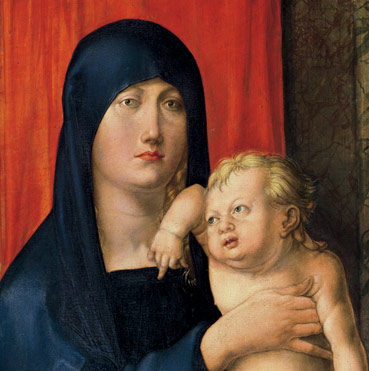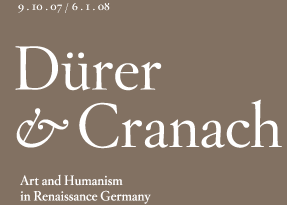
Albrecht Dürer
Virgin and Child (Madonna Haller), c. 1498 (detail)
Virgin and Child (Madonna Haller), c. 1498 (detail)

Dürer and Cranach. Art and Humanism in Renaissance Germany is a survey
of German art between the late 15th century and the first half of the 16th
century. Among the aims of the exhibition, which focuses on the two
greatest artists of the day, Albrecht Dürer and Lucas Cranach the Elder,
is that of emphasising the key role that artistic images played in a series
of contemporary events which would ultimately bring about profound
changes in art, religion and politics. The exhibition is divided into two
sections, which are displayed in its two venues: The World of Artists at
the Museo Thyssen-Bornemisza, and A World in Conflict at Fundación
Caja Madrid.
Museo Thyssen-Bornemisza
1
Pride and Melancholy: an image of the German artist
2
Nuremberg
3
Italy: “Here I am a gentleman”
4
In the collector’s cabinet (1): witches, monsters, nudes
5
In the collector’s cabinet (2): new ideas of beauty
6
Dürer: science and painting
7
“Apelles Germaniae”
8
A German portrait?
Fundación Caja Madrid
9
Images for salvation (1)
10
Images for salvation (2)
11
Maximilian I
12
Images as words
13
From chivalry to canons: a new image of war
The organisers of the exhibition would like to thank all those museums, cultural institutions and private collectors who have loaned works, in particular the Musée du Louvre, the Biblioteca Nacional de España and the Baron Edmond de Rothschild Collection.
Link to the "Cranach" exhibition at the Royal Academy of Arts, London

This website fulfills the norm of accessibility AA.
Museo Thyssen-Bornemisza
1
Pride and Melancholy: an image of the German artist
2
Nuremberg
3
Italy: “Here I am a gentleman”
4
In the collector’s cabinet (1): witches, monsters, nudes
5
In the collector’s cabinet (2): new ideas of beauty
6
Dürer: science and painting
7
“Apelles Germaniae”
8
A German portrait?
Fundación Caja Madrid
9
Images for salvation (1)
10
Images for salvation (2)
11
Maximilian I
12
Images as words
13
From chivalry to canons: a new image of war
The organisers of the exhibition would like to thank all those museums, cultural institutions and private collectors who have loaned works, in particular the Musée du Louvre, the Biblioteca Nacional de España and the Baron Edmond de Rothschild Collection.
Link to the "Cranach" exhibition at the Royal Academy of Arts, London

This website fulfills the norm of accessibility AA.



